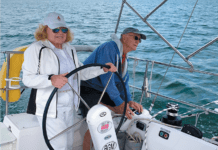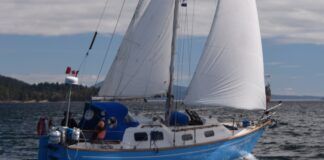Line Choices
Simple common sense tells you that increasing the number of dock lines means decreasing the chances that a boat will break loose. In the case of Hurricane Fran in 1996, a BoatU.S. catastrophe team that visited the landfall site in North Carolina estimated that as many as 50 percent of the boats damaged could have been saved by using more and better dock lines. The team collectively specified the need for lines that were longer, larger, arranged more sensibly, and better protected against chafe. This information appears in BoatU.S.s publication “The Boaters Guide to Preparing Boats & Marinas for Hurricanes,” a useful, 12-page booklet available at www.boatus.com. What you wont find there is exactly what kind of line to use.
Practical Sailor investigated nylon line, and after breaking several used docklines (some as old as 12 years), testers found that some of the lines broke at one-third their ratings when new. This is due to UV degradation as well as the wear and tear of load cycling. Testers also determined that larger-diameter lines are definitely better. They have more mass to withstand chafe longer, and surging waters can move a boat so violently that dock lines stretched over a chock or rail will create sufficient heat to begin melting the fibers internally. The larger the line, the less stretch and the less chance of internal melting.
Line experts at New England Ropes recommended three-strand nylon line for its elasticity (to absorb dynamic loading), toughness, and the ability to withstand physical abuse. Other studies have suggested joining nylon and polyester line in the same tether. Their argument: Nylon absorbs dynamic loading better, but polyester line (like Dacron) has shown better abrasion resistance and is less liable to heat-related failure.
The authors of one study conducted by the Massachusetts Institute of Technology on line chafe suggest connecting nylon and polyester ropes via eye splices in each, with the polyester portion leading through a chock or over the rail to the connecting splice. Anyone taking this approach should factor in roughly a 10-percent drop in line strength due to that splice. (Knots diminish line strength even more. Practical Sailor tests indicate that bowlines reduce line strength at the knot by about 30 percent.)
With due care to splices, chafe gear, and unions, adding a polyester tether to cope with inevitable chafe points is viable. In Practical Sailors view, however, conservatively sized, new-or lightly used-high-quality, three-strand nylon line and superior chafing gear are a suitable, cost-effective, and practical means of securing to fixed points ashore during a storm. To reduce elasticity or increase chafe protection, increase line size.
Although three-strand nylon line has excellent elasticity, it is likely that a snubbing device to absorb shock loading will lengthen the lines lifespan. There are numerous products on the market that have been developed to do that: Shockles and Bungy Schock Absorbers are among those products reviewed in the past by Practical Sailor testers.
These products are generally designed to absorb some of the line strain in normal docking and anchoring conditions, and although we have load tested a few of them to their useful maximum, we have not used them in actual storm conditions. While some of the more rugged units should help reduce chafe and heat build-up in the early parts of a storm, they would likely break or stretch beyond their useful limit in a storm. Again, any knots or splices will weaken a system. A relatively new entry into the field are lines with integrated snubbers, such as those sold by Synergy Marine. Synergy offers braided polyester dock lines from half-inch to 1-inch diameters. The shock absorber is simply a section of bungee cord that is inserted during the braiding process. Practical Sailor has yet to test this product.
Ultimately, the best storm strategy regarding dock lines is to make sure you keep new lines on hand for heavy-weather applications. Go with the largest diameter that your boats cleats or deck fittings will accommodate, maximize chafe protection, and double up on each line.
For additional information on maintaining healthy dock lines, purchase Bill Seifert’s Offshore Sailing, 200 Essential Passagemaking Tips today!





































